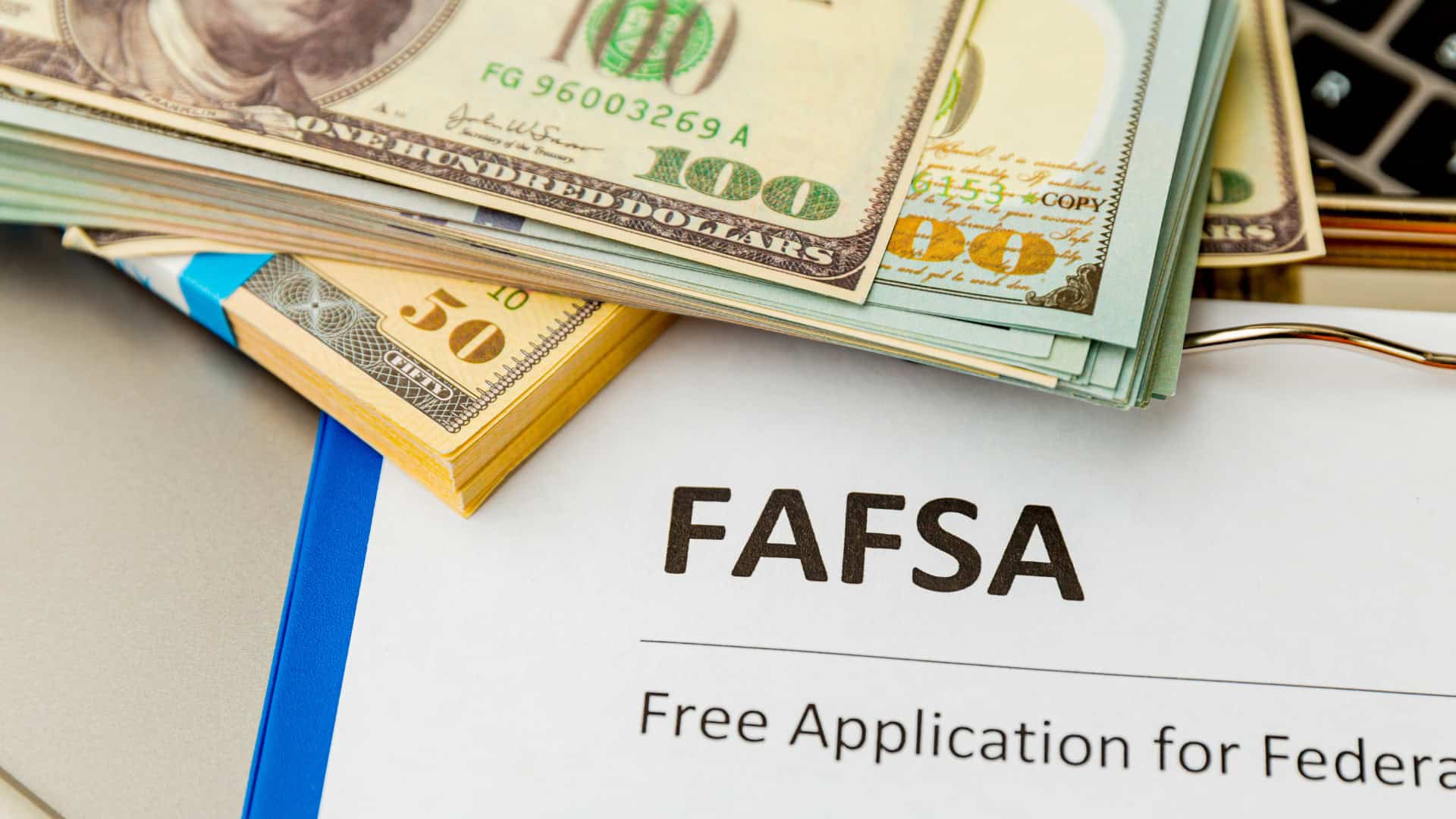Paying for college can feel like a lot, but FAFSA (Free Application for Federal Student Aid) is here to help. It gives you access to federal grants, scholarships, work-study programs, and low-interest loans. These options make college more affordable. But how much money can you actually get?
The amount you receive isn’t the same for everyone. FAFSA looks at factors like your family’s income, school costs, and federal funding limits. Some students get grants they do not have to pay back, while others may need federal loans with borrowing limits.
In this guide, you will learn about the maximum amount of money FAFSA gives, the types of aid available, and how to increase your chances of getting more funding.
Key Takeaways
- FAFSA award amounts depend on financial need, school costs, and federal limits.
- Pell Grants and FSEOG provide free aid, while loans must be repaid with interest.
- Applying early increases your chances of receiving more financial aid.
- You can appeal for more aid if your financial situation changes.
- Exploring scholarships and alternative funding sources can reduce college expenses.
Understanding FAFSA and How It Works
FAFSA, or the Free Application for Federal Student Aid, is key for those seeking higher education in the U.S. It’s important to know who can apply for federal aid and how aid is given out. This aid is for U.S. citizens and some non-citizens who show they need help financially. This need is based on income, assets, and family size.
Who is Eligible for FAFSA?
To qualify for FAFSA, you must meet certain criteria. These include:
- Being a U.S. citizen or eligible non-citizen
- Being enrolled or accepted in a degree or certificate program
- Showing financial need based on income and household size
- Meeting income limits set by the U.S. Department of Education
These factors help decide who gets federal student aid, such as grants, loans, and work-study. Your financial need is key in this decision. It’s based on what you report on your FAFSA application.
How FAFSA Determines Your Financial Aid
Figuring out your financial planning and aid involves a few important parts. These are your Expected Family Contribution (EFC) and your school’s Cost of Attendance (COA). Here’s how they affect your aid:
| Factor | Description |
| Expected Family Contribution (EFC) | The amount your family is expected to contribute towards your education based on your financial situation. |
| Cost of Attendance (COA) | The total estimated costs of attending school, including tuition, fees, room, board, and other related expenses. |
Your financial need is the difference between your COA and EFC. When you apply for FAFSA, it checks your income against the aid eligibility limit. This check affects the federal student aid you might get. Knowing these parts helps you make the most of your financial aid.
Maximum FAFSA Award Amounts: How Much Can You Get?
FAFSA offers different types of financial aid, each with its own limits. The amount you receive depends on your financial need, school costs, and federal funding rules. Some aid, like grants, doesn’t have to be repaid, while loans must be paid back with interest.
Federal Pell Grant Limits
The Federal Pell Grant is one of the most well-known need-based grants for undergraduate students. Unlike loans, Pell Grants do not need to be repaid, making them a valuable source of financial aid. The maximum Pell Grant amount for the 2024-25 academic year is $7,395.
However, not every student will qualify for the full amount. The grant you receive depends on factors such as your Expected Family Contribution (EFC) (soon to be called the Student Aid Index), your school’s cost of attendance, and your enrollment status (full-time or part-time).
Students can receive Pell Grants for up to 12 semesters (about six years). If you qualify for the maximum amount each year, this could total over $44,000 in Pell Grant funding throughout your college career. Since Pell Grants are awarded based on financial need, students from lower-income families tend to receive higher amounts.
Federal Supplemental Educational Opportunity Grant
The Federal Supplemental Educational Opportunity Grant (FSEOG) is another need-based grant available to undergraduate students with exceptional financial need. Unlike the Pell Grant, which is funded directly by the federal government, the FSEOG is distributed by individual schools. Because of this, not every college offers it, and funds are limited.
If your school participates in the FSEOG program, you could receive anywhere from $100 to $4,000 per year, depending on your financial need, when you apply, and your school’s funding availability. Since funds are awarded on a first-come, first-served basis, submitting your FAFSA early increases your chances of receiving this grant. Your school will automatically include FSEOG funding in your financial aid package if you qualify.
Direct Subsidized and Unsubsidized Loan Limits
Federal student loans are another option for covering college costs. Unlike grants, private student loans must be repaid, but they come with lower interest rates compared to federal loans. The amount you can borrow in federal aid depends on your year in school and dependency status.
For dependent undergraduate students, first-year students can borrow up to $5,500, subsidizing no more than $3,500. In the second year, the limit increases to $6,500, with up to $4,500 in subsidized loans. Third-year students and beyond can borrow up to $7,500, with a maximum of $5,500 subsidized. The total lifetime borrowing limit for dependent students is $31,000, of which $23,000 can be subsidized.
Independent undergraduate students have higher limits. In the first year, they can borrow up to $9,500, with $3,500 subsidized. The second-year limit increases to $10,500, with a $4,500 subsidized cap. Students can borrow up to $12,500 for the third year and beyond, with $5,500 subsidized. The lifetime borrowing limit for independent students is $57,500, with a cap of $23,000 for subsidized loans.
Subsidized loans are the better option since the government pays the interest while you are in school. Unsubsidized loans start accruing interest as soon as they are disbursed, meaning your loan balance will grow while you are still in college.
PLUS Loans for Parents and Graduate Students
If grants and federal student loans are not enough, PLUS Loans can help cover remaining costs. These loans are available to parents of dependent undergraduate students (Parent PLUS Loans) and graduate or professional students (Grad PLUS Loans). Unlike other federal loans, PLUS Loans require a credit check, which means approval depends on your financial history.
With PLUS Loans, parents and graduate students can borrow up to the full cost of attendance minus any other financial aid received. While this offers flexibility in covering tuition, room, board, and other expenses, PLUS Loans come with higher interest rates than subsidized and unsubsidized student loans. As of 2024, the interest rate for PLUS loans is 8.08%, and interest starts accruing immediately after the loan is disbursed.
Since PLUS Loans do not have strict borrowing caps like undergraduate loans, families should carefully consider how much they borrow to avoid excessive debt. If the cost of borrowing seems too high, students should look into scholarships, work-study opportunities, and state financial aid programs as alternatives.
Factors That Affect Your FAFSA Award Amount
Overwhelmed by college research?
Let us help save time and find the perfect schools for your family.
Knowing what affects your FAFSA award is key for planning your personal finances. Many things play a role, like the Expected Family Contribution (EFC) and the cost of attending your school. Understanding these helps you see how much aid you might get.
- Expected Family Contribution (EFC)
The EFC is how much your family is expected to pay for your education. It’s based on the financial info you give in your FAFSA. Schools use it to figure out how much aid you need. If your EFC is low, you might get more aid. But a high EFC could mean less aid for you.
- Cost of Attendance (COA) at Your School
The COA includes tuition, fees, room, board, and other costs. Each school has its own COA, which affects how much aid you can get. Knowing your school’s COA helps you plan for your expenses during college.
- Dependency Status and Household Income
Your dependency status is very important for FAFSA eligibility, as it can affect your aid offer. If you’re independent, you might get more aid because your parents’ income isn’t counted. Knowing your status and how it affects your income helps you understand your aid options.
How to Maximize Your FAFSA Financial Aid
Getting the most financial aid from FAFSA is about timing, strategy, and knowing your options. The amount of aid you receive depends on your Expected Family Contribution (EFC), school costs, and available federal funding. However, there are ways to increase your chances of receiving more grants, loans, and work-study opportunities.
Applying Early and Meeting Deadlines
FAFSA operates on a first-come, first-served basis, meaning that students who apply early have a better chance of receiving more aid. Some financial aid, like the Federal Supplemental Educational Opportunity Grant (FSEOG) and state grants, have limited funds that run out quickly.
The FAFSA application opens on October 1st each year, and many states and colleges have their own deadlines, which can be much earlier than the federal deadline. Submitting your FAFSA as soon as possible gives you access to more grant money, better loan options, and additional financial aid opportunities, including federal aid.
Reducing Your EFC Legally
Your Expected Family Contribution (EFC) plays a major role in determining how much financial aid you receive. A lower EFC means a higher chance of getting need-based aid like Pell Grants and subsidized loans. While you can’t change your family’s income, there are legal ways to reduce your EFC and maximize your aid.
One strategy is to reduce reportable income before filing FAFSA. Since FAFSA looks at prior-prior year income, avoiding large one-time income boosts (like selling investments) during the base year can lower your EFC.
Another tip is to minimize student assets in your child’s name. FAFSA assesses 20% of a student’s assets but only up to 5.64% of parental assets. Shifting student savings into a 529 college savings plan (owned by a parent) instead of a standard savings account can lower your EFC and increase your aid eligibility.
Families should also maximize contributions to retirement accounts before filing FAFSA. Retirement savings are not counted as assets in FAFSA calculations, meaning that putting extra money into a 401(k) or IRA won’t impact your financial aid eligibility.
Exploring State and Institutional Aid
FAFSA also connects you to state and college-based financial aid programs, which may include federal aid. Many states offer grants, scholarships, and tuition assistance programs that can significantly reduce college costs.
For example, the Cal Grant in California, the TAP Grant in New York, and the Bright Futures Scholarship in Florida all provide substantial financial aid to eligible students. Each state has its own requirements, and many of these programs require you to submit FAFSA early to qualify for federal aid.
Colleges also offer their own institutional aid in the form of need-based grants, merit scholarships, and work-study programs. Some schools have FAFSA priority deadlines, meaning that students who apply early get first access to school-based grants and scholarships.
Common Mistakes That Reduce Your FAFSA Award
Many students make mistakes on the FAFSA that can hurt their financial aid. These errors can cut down on your aid and make it harder to get federal help. Knowing these mistakes is key to getting the most aid possible.
- Failing to report all income: Accurate income reporting is essential. Omitting income sources can result in less aid being awarded.
- Neglecting to sign the application: A missing signature renders your application invalid, making it impossible to process your request for financial aid.
- Missing deadlines: Submitting your FAFSA after the deadline can result in losing out on valuable financial aid opportunities.
- Inaccurate Social Security numbers: Any discrepancy in Social Security numbers can lead to application errors that affect aid eligibility.
- Inconsistent information: In this context, discrepancies between the FAFSA and other financial documents create complications that may delay or deny aid.
It’s important to check your application carefully before you send it in to ensure you receive the best aid offer. By fixing these common mistakes, you can make sure your FAFSA shows you’re eligible for aid. This way, you can get the money you need for school.
What to Do If Your FAFSA Award Isn’t Enough
There is a chance that your financial aid package falls short. In such cases, you can appeal for more aid, find additional funding, and explore alternatives to make college more affordable.
Appealing for More Financial Aid
If your financial situation has changed since you submitted your FAFSA, you may be able to request a financial aid appeal. Schools understand that life circumstances, like a parent losing a job, high medical expenses, or unexpected financial hardships, can impact your ability to pay for college.
Contact your school’s financial aid office to appeal and ask about their professional judgment or special circumstances appeal process. You will likely need to submit a written request and supporting documents (such as tax returns, medical bills, or layoff notices) to prove your case.
Each college has its own policies, but a successful appeal can result in more grant money, additional work-study opportunities, or adjustments to your aid package.
Looking Into Work-Study Programs
Federal Work-Study (FWS) can help bridge the gap if your FAFSA award isn’t enough. This program provides part-time jobs for students with financial needs, allowing them to earn money while in school. Work-study positions are available on-campus or with approved employers and are designed to be flexible around your class schedule.
The amount you earn depends on your school’s funding and financial need, but students typically earn minimum wage or higher. While work-study will not completely cover tuition, it can help with day-to-day expenses like books, supplies, and transportation.
Finding Additional Scholarships and Grants
If your FAFSA award does not cover everything, scholarships and grants can fill in the gaps, and they do not have to be repaid.
Start by looking for institutional scholarships offered by your college. Many schools have need-based, non-need-based aid, and merit-based awards that students can apply for separately from FAFSA. Some of these scholarships have early deadlines, so check with your school’s financial aid office.
You should also search for private scholarships. Many organizations, nonprofits, and businesses offer thousands of dollars in scholarship money each year.
Conclusion
FAFSA is a powerful tool that can help you pay for college, but the amount you receive depends on your financial need, school costs, and federal funding limits. From grants that don’t need to be repaid to loans that come with low interest rates, FAFSA opens the door to multiple funding opportunities. The key to maximizing your aid is applying early, reducing your Expected Family Contribution (EFC), and exploring additional scholarships and grants.
About College Journey
Navigating the FAFSA application process and financial aid options can feel overwhelming, but College Journey is here to make it simple. With Alice, your AI-powered college counselor, you’ll get clear guidance on financial options and how colleges evaluate important factors like GPA, test scores, extracurriculars, and essays.
Alice is ready to assist if you need help understanding how your academic achievements and personal qualities shape your application, advice on standing out in activities, or tips for writing a powerful personal statement. From personalized recommendations and college comparisons to tools that help you track your progress, College Journey takes the stress out of college prep.
And the best part? Signing up is completely free!
FAQ
Can I receive FAFSA aid for online college programs?
Yes, as long as your online school is accredited and participates in federal financial aid programs.
Does FAFSA cover summer classes?
You can cover your summer classes with FAFSA. However, the funding depends on your remaining financial aid eligibility and your school’s policies.
Can I get FAFSA aid if I’m an independent student?
Yes, independent students qualify for aid without considering their parents’ income, but loan limits may be higher.
What happens if I don’t use all my FAFSA money?
Unused grant money does not need to be repaid, but leftover loan funds should be returned to reduce debt.
Does FAFSA cover housing and living expenses?
FAFSA funds can be used for tuition, housing, food, books, and other school-related expenses.




